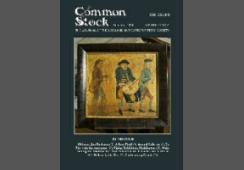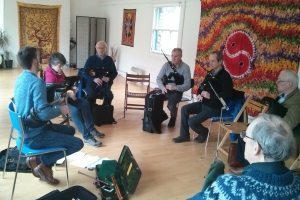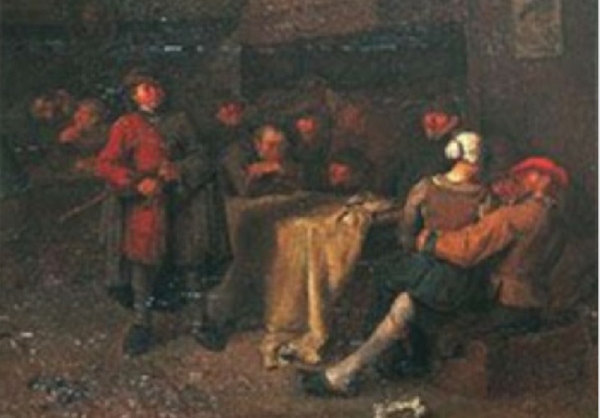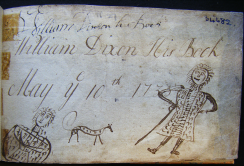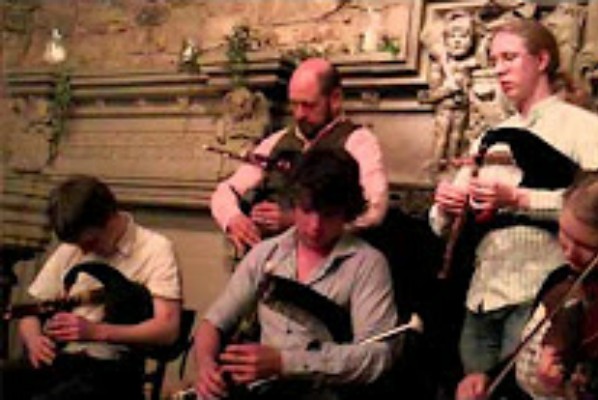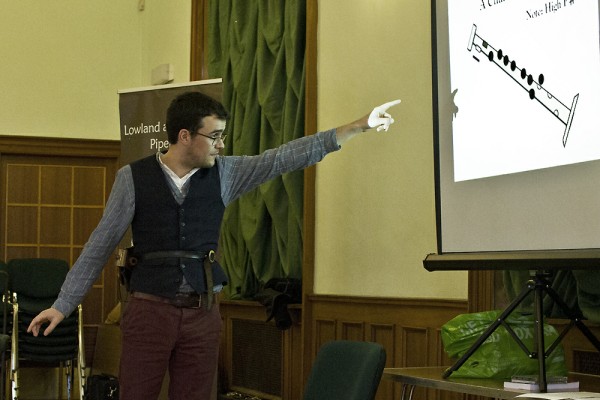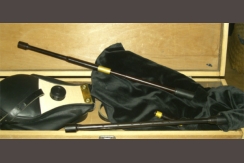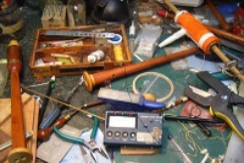




John Dally
Dynamics, or the relative loudness emitted from an instrument, is a subject that we pipers do not usually consider We have enough to think about, I suppose. But the pipe chanter does have its own subtle dynamics, note by note, and these vary from one type of chanter to the next. In this article we will examine the various kinds of dynam- ics available from different types of pipe chanters, how they affect the music we play, as well as how we might take advantage of them to produce the best music.
I don’t promise a scientific study. These are observations and, hopefully, insights based on my own experience. Many are very basic. This is not an attempt at scholarship either. Better scholars than myself will possibly find evidence contrary to or in support of my observa- tions in historical documents. That is interesting, but does not concern me here.
These observations are based on my own use of my own sets of pipes that I have set up my- self. You may observe different results from your pipes. Some of my observations are based on very fine subtleties. These subtleties are enhanced on a well-balanced, well-tuned pipe with a beautiful tone. You might not hear them otherwise. And, finally, there is always the matter of personal taste.
We don’t think much about dynamics because one of the distinguishing features of a bag- pipe is its constant flow of sound. Another is the piper’s inability to produce a variety of volumes for affect, such as pianissimo and forte, as readily as a fiddler can. A piper can change the dynamic of the drones, but we usually practice very hard to keep it constant. A constant dynamic in the drones produces the most beautiful tone.
Inconsistent pressure on the bag produces a surging fluctuation. This is considered poor “blowing” technique. A more accurate term than “blowing” for what the piper does is “squeezing.”
General dynamic features distinguish different kinds of pipes. Highland pipes are loud. Border pipes are not as loud. Scottish small pipes are not nearly as loud, although small pipes from one maker may be louder or quieter than those made by another maker. The reeds and small differences in bore sizes will determine relative loudness within one type of bagpipe.
Each kind of pipe has its own characteristic dynamics as well.
.... notes that are harmonically sympathetic with the drones will seem louder than notes that are dissonant with the drones
A conical chanter, such as those of Highland pipes and Border pipes, like a trumpet, is designed so that the sound waves stack up in the bore.
This results in the notes becoming louder as the sound travels down the bore. The top notes are not as loud as the bottom notes. The notes on a Highland or Border pipe chanter grow progressively louder as you finger down the scale.
In my experience, without scientific measurements to prove it, the low ‘G’ is the loudest note on my conical chanters. Chanters with particularly large ‘C’ holes may actually pro- duce the loudest note on ‘C’. Also, notes that are harmonically sympathetic with the drones will seem louder than notes that are dissonant with the drones.
The cylindrical chanter of the Scottish small pipes allows sound waves to flow down the bore, lengthening as they go. Imagine a stone thrown into a pool. The wave produced is most intense close to where the stone broke the surface.
The strength of the wave is spread out over its diameter as it widens from the center, the in- tensity dissipates at any one point as it travels to the edge of the pool.
I have been told this metaphor is not really accurate when applied to sound waves, but it is useful for the purposes of this discussion. The sound waves produced by the reed are most intense at the base of the reed, making the top notes louder than the bottom notes.
The dynamic difference is most pronounced between the highest and lowest notes, whereas there is little difference between notes next to each other. There is little difference in volume between a high ‘A’ and a high ‘G’, for example, but quite a bit of difference between a high ‘A’ and a low ‘G’. This is true on both kinds of chanters.
The dynamics run opposite to each other in the two kinds of chanters. The conical chanter goes quiet to loud, top to bottom. The cylindrical chanter goes loud to quiet, top to bottom. I am using “loud” and “quiet” as relative terms.
The two different types of chanter also produce very different tone qualities as a result of their design differences, but this article deals only with dynamics.
In my experience, the difference in loudness between the top notes and the bottom notes on a cylindrical chanter is more pronounced in a long chanter than in a short one. My ‘D’ small pipe chanter is nearly uniform in loudness from top to bottom in comparison with my ‘A’ small pipe chanter.
The same tune will sound different when played on a cylindrical chanter from how it sounds on a conical bore chanter, not only because the tone will be different but also because different notes will dominate it dynamically.
Take “Sandy Duff” as an example of this. Play it on a Scottish small pipe, and then on a Highland pipe.
On the small pipe the first high ‘A’ really opens the tune up with strength. In the second part you have the phrases that juxtapose the top hand notes with the bottom hand notes, making the top hand notes pop dramatically out of the bottom hand notes, which practically disappear in the sound of the drones.
On the Highland pipe the high ‘A’ disappears into the sound of the drones. “Sandy Duff’ still sounds great on the Highland pipe, but the melody does not pop off the chanter from the start the way it does on the small pipe.
On the other hand, so to speak, take the tune “Cameronian Rant” in reel time as it appears in Barry Shears’ book, The Cape Breton Collection of Bagpipe Music.
This strong bottom hand tune nearly disappears into the drones on the small pipe. The lovely grace note punctuation sounds shrill while muffled melody notes blur together. But the tune thumps along aggressively on a conical chanter. The second part provides a very nice dynamic contrast to the first, moving to the opposite end of the chanter.
“Caber Feidh” is a tune that sounds great on both kinds of chanters, but for different reasons. Like “Sandy Duff’ it begins on the top hand, making a strong first impression on the cylindrical chanter.
But like “Cameronian Rant” it has used the bottom hand to make very strong statements, rhythmically punctuated by grace notes. When I play it on the small pipe I feel the need to finish it off with a return to the first part.
There is a traditional, perhaps half-conscious, use of dynamics in pipe music composition. The typical four part Highland pipe competition march, for example, begins with a thorough use of the notes of the conical chanter, while emphasizing the bottom, loud notes to make the initial statement. The second part rises to the top hand and usually lives there. The third part pounds away on the bottom hand, contrasting low ‘A’s with low ‘G’s a good deal of the time, featuring the heavy bottom hand toarluath ornament in many cases. The final part may again reside in the top hand or run about the length and breadth of the scale, but it almost always resolves with a couple of strong, bottom hand phrases.
There are hundreds of examples of this - a quick look at the classic march, “Captain Carswell,” will confirm this observation. Jigs, hornpipes, strathspeys and reels all follow, or play with, this basic dynamic pattern. It is part and parcel of the melodic patterning. The two together with rhythmic patterning make the tune what it is.
When I hear Highland pipers criticize small pipes they often say the tunes sound half dead on the small pipes, that the notes and doublings don’t pop off the chanter in the same way they do off the Highland pipe chanter. In general, they feel the music loses most of its power and beauty on the small pipe. They also criticise the small pipes for “chirping.” There is truth in all of this, because of the dynamics of the small pipe versus the Highland pipe as stated above.
Unfortunately, these same critical pipers often do not recognize the unique dynamic and tonal qualities of a well made, well reeded and well played Scottish small pipe. Their ears must be so attuned to the modern, Highland pipe norm that it is difficult lot them to recognize or consider a different kind of sound, tone and dynamic.
Sometimes they characterize the small pipe as a “practice instrument.” Many of the mass-produced, plastic-reeded, mouth-blown small pipes popular with Highland pipers are, indeed, practice instruments. The chanters on most of these sets are actually practice chanters and a different animal altogether from a well made Scottish small pipe chanter. Although the dynamics are the same, the tonal quality of these practice pipes is tremen- dously inferior to a proper Scottish small pipe.
There are pipers raised in the Highland tradition who have internalized the sound of the small pipe at this point, fifteen years on from its invention. They have made new tunes especially for it. A contemporary composition provides an interesting example of a tune made for the Scottish small pipe in the form of a modern hornpipe - Anna Murray’s “Hazy Day”. Anna plays this sweet tune on her recording, Into Indigo. She told me the tune was composed on the small pipe, and it certainly fits on the small pipe with a real sense of purpose. On the Highland pipe it doesn’t show off its lush qualities to their best advantage, although it still sounds great. The first three parts of the tune are in B minor, a key that seems to fit better on the small pipe in ‘A’ than the Highland pipe, but that may be a matter of taste.
Guitar accompaniment effectively buries the middle and low notes on a small pipe ‘A ’ chanter unless the volume of the chanter is enhanced significantly
Later in the same set Anna plays R.S. Mac- Donald’s modern classic, “The Last Tango in
Harris.” This shows how a tune that takes advantage of the disappearing high ‘A’ on the Highland pipes will sound like a series of high ‘A’ bleeps on the small pipe, with the low hand melody disappearing into the guitar and bass accompaniment. Guitar accompaniment effectively buries the middle and low notes on a small pipe ‘A’ chanter unless the volume of the chanter is enhanced significantly. But even then the end result may be a lost and bleating high ‘A’.
Dynamics are also important to consider in how a tune is graced and ornamented on one type of chanter versus another. Frowning Highland pipers complain about small pipes “chirping.” This results from the loud high ‘G’ on the smallpipe. The high ‘G’ grace note can be overused very quickly on any pipe, but it can mar a small pipe performance of a tune like “Jenny Dang the Weaver.” The high ‘G’ grace note is softer than the notes it graces on the Highland chanter.
Interestingly enough, after I played my new Highland pipe chanter in ‘A’ made by Hamish Moore, for a few weeks I went back to the B flat chanter. The sound seemed surreally shrill and thin, and the ornamentation chirping in the extreme. Your frame of reference matters a great deal in your response to a quality of sound.
The dynamics of the Highland chanter in ‘A’ in comparison with the Highland chanter in B flat are worth mentioning here. The bottom hand is stronger on my ‘A’ chanter, while the top hand is ethereal. There is more difference in loudness between the top of the chanter and the bottom than there is on the B flat chanter. One of the things my teacher, Colin MacRae,
who was taught in the ‘40s by a piper who won the Silver Star in 1899, always complains about at the contests these days is what he characterizes as a weak bottom hand. When I played a pibroch for Colin on my ‘A’ pipes, however, he was thrilled to hear the strength in the bottom hand that he has missed for so many years. Unfortunately, I did not actually play the movements any better on the ‘A’ chanter than I did on the ‘B’ flat chanter. It was the chanter itself that produced the sound Colin wanted to hear. The sound of the toarluath and crunluath movements was different as well.
When you consider that most pibrochs are bottom hand tunes, it makes sense that pipers who used a chanter with a loud bottom hand, and quiet top hand, would use the strongest notes for the themes of Salutes, battle tunes, rowing tunes, Marches and Gatherings. A quick glance through Angus MacKay will show this to be the case. When the upper hand is employed, as in a “thumb” variation, the sound is very quiet, almost inaudible, when com- pared to the sound of a modern chanter. This lends credence to the supposition that the old chanters were once set at a lower pitch than they are today.
The ‘E’ alto drone performs a very important service .. to the top hand of the chanter by reinforcing the quieter, high notes.
The drone configuration on the tra- ditional Border pipe is bass, tenor and ‘E’ alto. The ‘E’ alto drone should “disappear” into the overall sound of the pipes. The sounds of the drones and chanter ought to come together seamlessly, as we
know, but the ‘E’ alto drone when set up and tuned properly ought to be “invisible.” The E alto drone performs a very important service, however, to the top hand of the chanter by re- inforcing the quieter, high notes.
Attention to dynamics will also serve us in the technique and placement of grace notes and ornamentation. New styles of grace notes and ornamentation have and will continue to de- velop for the small pipe and Border pipe as more pipers devote themselves to these elegant instruments, and we begin to hear them with ears that are not trained only for the Highland pipes. The significance of the tradition of the Northumbrian small pipe cannot be underesti- mated as this organic development takes shape.
Attempts to impose or define the “correct” methods are, I think, premature and stunting. What follows is a description of my own experience, offered with the hope that there might be something you, gentle reader, might find useful.
Experiments using ‘F’ and ‘E’ grace notes in place of the high ‘G’ on the small pipe and Border pipe have produced some very satisfying results, but again this may be a matter of taste. Hamish Moore was the first to suggest this to me on the Border pipe. Jock Agnew has also used ‘F’ as a grace note effectively on his Border pipe.
Single low ‘A’ or low ‘G’ taps, or shakes, are very useful separations of notes of the same pitch. These are common in many piping traditions. Double taps make great punctuation, but require control and restraint. Half doublings are also very good alternatives to high ‘G’ based doublings. Old style doublings are very useful, where you play a double grace note on top of the theme note, such as two successive ‘D’ grace notes on ‘C’. These old style doublings give the emphasis you want without a shrieking bleep on every up and down beat. And they do not require a tremendous amount of relearning.
One way to use the high ‘G’ grace note is to play it on the off beat, or back beat, after an unadorned theme note on the beat. This gives your tune lift and syncopation, playing off the expectation of a high-pitched bleat appearing in the music with the regularity of a metro- nome. You will find this off beat high ‘G’ grace note followed by ‘D’, ‘E’ or ‘C’ grace notes or shakes in the jigs of Terry Tully. To my ear this works especially well on the small pipe and Border pipe.
...a quick trill on an upper hand theme note can do as much work as a doubling
There are piping traditions which use a trill, or vibrato, throughout each and every tune, or so it seems. Trills fit in slow airs when
used sparingly, but trills can make a pipe tune sound like bad opera much work as a dou- bling. Try this in a tune where it is least expected, like on the E’s in the first part of the “Athol Highlanders.” The trill is most effective and versatile on the Border pipe, but do not over use it or think of it as an easy thing to do. A trill executed well is as difficult to produce as a splendid birl.
Heavy low hand ornaments, such as the birl, grip, bubbly and toarluath do not rip from the small pipe chanter with the same percussion they have on the Highland pipe. There are historical reasons for not using these movements on the Border pipe chanter, but the very nature of my Border pipe chanter does not encourage them. My Border pipe chanter will crow like a startled peacock if I attempt a toarluath from the upper hand. Grips can also produce this squawk. Birls work well, however, especially when played open. There is no forgiveness in this chanter.
Northumbrian style ornaments work as well as or better than any Highland pipe ornament on my Border pipe chanter. These are for the most part slight lifts or dips around the note being graced, and in general are very spare. I play Border music on my Border pipes because I enjoy it, but also because it sounds better for the reasons stated above. I would play more Highland style music on it if the Border chanter accepted it without protest.
The small pipe does enhance the sound of edres and chedres. They lend the sound of an Irish cran to a tune when opened up so that their rhythm comes through. They are quite nice in jigs, though you will very rarely see them in published jigs. They usually appear in reels and hornpipes, but try them in a jig the next time you find a place that will take it.
One aspect of Highland ornamentation technique that is taken for granted among most of the small pipers and Border pipers I hear, live and on recordings, is the very quick, even,
uniform way in which all doublings are played. I have met enough old pipers to know that this is not the way it always was. The first low ‘G’ in the throw on ‘D’ might be emphasized by a nearly unrecognizable pause. Barry Shears uses this heavy low ‘G’ grace note in most of the throws on ‘D’ that he makes on the Highland pipe as well as the smallpipe. You can hear them on his recording A Cape Breton Piper. Double ‘F’ is another doubling where you might accentuate the first ‘G’ grace note in order to add subtlety to you expression. That is considered poor technique in a competition, however.
My Border Pipe allows cross fingering and tasty vibrato, but it also demands solid, clean fingering
My Border Pipe allows cross fingering and tasty
vibrato, but it also succumbs to chirping high ‘G’ grace notes. It demands solid, clean fin- gering. Strong fingers on the chanter produce strong, popping notes. And this in itself is a way to do away with too many chirping ‘G’ grace notes. I can “wallow” in and between notes much more effectively than on a Highland pipe, getting sounds that are very similar to the Uillean pipe. The tone is nasal in comparison with a Highland pipe chanter, giving it a different harmonic “taste.” There is no “wallowing” allowed on my small pipe chanters.
Use of an open ‘C’, with only the ‘D’ finger down as opposed to the College of Piping direction to put both ‘D’ and ‘G’ fingers down on the bottom hand, allows me to make very satisfying low ‘G’ grace notes. Jock Agnew also happily employs the open ‘C’ [the chanter was designed that way Ed], Colin MacRae was taught the only way to play the sequence of ‘C’, low ‘G’ grace note, low ‘A’ common in ceol mor is with an open ‘C’. The closed ‘C’ will not provide the necessary slap to low ‘G’. He says the old chanters were made to sound a true ‘C’ when played open.
As new tunes are made to suit the unique sounds of these two bellows blown instruments, as more individuals devote their piping time and energy to them, ornaments will continue to change and develop. This is an exciting time. Attempts to impose direction or limits on this development are misplaced, I think.
Key to the process will be pipe-makers producing instruments of higher and higher quality. Musicians will have to do their part by blowing steady and setting their instru- ments up to produce a warm, complex tone rich in harmonics. We must play in tune, as well as use the best technique. Just as important as any clues we can glean from historical documentation will be a thorough understanding of the potential of our instruments. I hope this article showed you something new about dynamics and prompted fresh approaches in your own piping.




